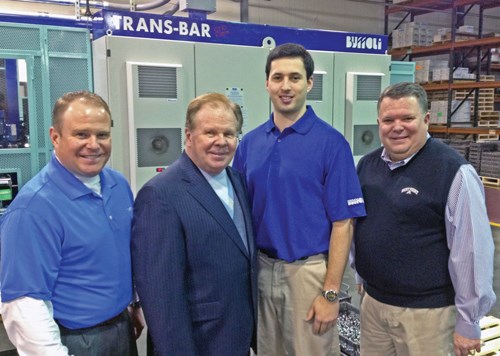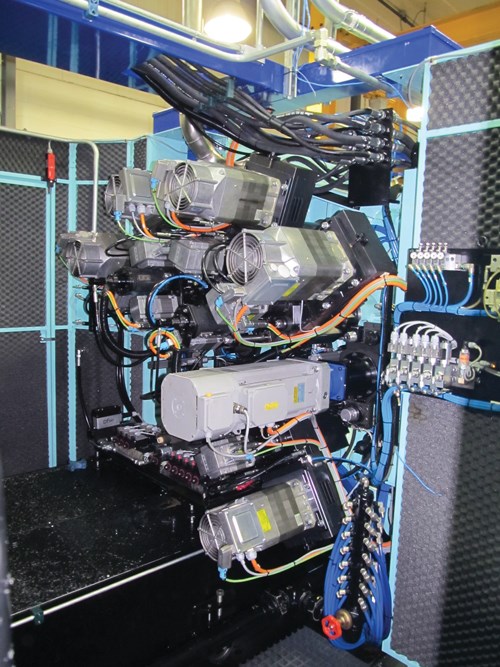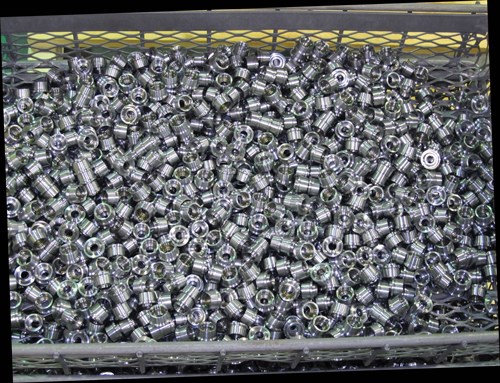Rotary Transfer: Turning Up the Volume
This contract manufacturer set its sights on high volume, precision turning and assembly of complex components from Day 1 and continues to succeed in a market many have abandoned using CNC rotary transfer machining.
Like many shops faced with changing customer demands, foreign competition and higher business costs, American Turned Products (ATP) chooses to invest strategically in manufacturing technologies that make sense for the business. By sticking with that philosophy, the company is well poised for the current uptick in automotive business from Detroit and from the transplants.
We sat down with Harry and Scott Eighmy at the company headquarters in Fairview, Penn., to discuss rotary transfer technology as it applies to the company and its ongoing commitment to high volume manufacturing of precision turned parts.
“Ours is a highly technical company,” Harry says. “ATP is on the cutting edge of new technologies, which makes us very competitive within the markets we serve.”
ATP is a high volume manufacturer primarily focused on serving the automotive industry as a Tier 2 supplier, making airbag, engine timing and fuel injection system components. It rounds out its production portfolio with customers in the fluid power, hydraulic and gas pipeline markets.
The Eighmy family has been in metalworking for more than 50 years. The company was started in 1984 by current company president, Jerry Eighmy, from seed corn of his father’s shop, founded in the 1950s. Since 1988, Jerry’s sons, Harry and Scott, have been active in the business with Scott serving as CEO and Harry as COO. With the help of Scott’s son, this fourth-generation family business operates two plants in northwestern Pennsylvania, one in Erie and its headquarters in Fairview, employing 150 people.
One of the hallmarks of ATP’s success is a willingness to invest in new technologies that provide it a competitive edge in the tough markets it serves. One example of such investment is the recent addition of a new Buffoli Trans-Bar trunnion-style rotary transfer machine, which augments the company’s production capabilities.
Making Many
Most of the technologies used for high volume manufacturing are built around the concept of progressive machining. The basic idea is to divide the various operations needed to complete a workpiece into relatively short operations that can be performed simultaneously rather than sequentially.
Machines designed to manufacture parts using progressive machining techniques include multi-spindles and transfer machines. The concept is the same for all: Perform a machining operation at one station, then index to the next with machining done at all of the stations simultaneously.
With each index of the drum or table, a complete part is dropped. Cycle time is determined by the longest operation at a given station. The more finely the machining can be divided among the number of stations available, the shorter the cycle time will be.
The primary machine tool platform for this progressive type of volume production is the multi-spindle. ATP has a virtual trade show floor of multi-spindle brands, starting with Gildemeister, Euroturn, Index and Schutte machines.
However, transfer technology is another means of achieving very high volume, progressive machining results. Transfer is either linear, moving work from station to station in a line or rotary, or moving work from station to station in a circle. ATP also has a stable of rotary transfer machines, primarily Hydromats. In the Hydromat configuration, the table indexes in a horizontal plane, like a merry-go-round.
The Buffoli trunnion machine, and all other such machines, uses the rotary transfer mechanism in a vertical plane, like a Ferris wheel. The word “trunnion” suggests the direction of rotary transfer. Literally, a trunnion is the pins on which a cannon is pivoted to get more or less elevation. In a machine tool, the trunnion is the horizontal shaft around which the turret disk holding the parts rotates. The size of the disk determines the number of stations it can hold.
Why Trunnion-Type Rotary Transfer?
Like many machine tool designs, the trunnion-style rotary transfer machine was developed for a relatively specific purpose. Using a vertically oriented disk that gripped workpiece blanks in the center, both ends of the work could be machined at the same time. In operation, the workpiece is held stationary in the jaws of the rotary disk. Cutting tool units, mounted on either side of the workzone, are fed to the part. The turning cutting tools orbit both ends of the part simultaneously, creating the cutting action.
The Buffoli machine that ATP owns is a ten station, 32-mm machine that is under full CNC. Each of the machining units generates X-Y and Z-axis motion, using ballscrew actuation, and independently controlled speeds of 6,000 to 8,000 rpm are standard. Units capable of 40,000 to 50,000 rpm are available if the application calls for it.
As the name Trans-Bar implies, the company’s machine uses barstock for continuous operation. The bar loader accepts a standard bundle of 12-ft. barstock.
On a typical horizontal turning center, the processing sequence is set up with most machining operations performed on the blank or bar in Op 10. Using a subspindle or pickoff, the remaining machining for Op 20 is done in the backworking position.
Many parts do not lend themselves to this machining scheme. A trunnion-style machine provides at least an equal amount of machining capability to both Op 10 and Op 20 without the need to make a workholding change. This maintains relative back to front location and leads to better tolerance repeatability.
According to Scott, “Trunnion machines are well applied when there is a significant amount of machining required on both ends of the part. Simultaneous, two-ended machining is very efficient when locations must be held from one end to the other more stringently than can be performed on horizontally oriented rotary transfer machines or main/subspindle turning centers, where the work must be regripped to machine complete.”
Workholding
On the Buffoli machine, each station on the trunnion disk has its own chuck with a set of master jaws that are programmable as to stroke and pressure. These master chuck jaws are the foundation for the workholding system.
Application-specific jaws, machined to conform to the workpiece geometry, are attached to these master jaws. The system allows for quick change-over from job to job. The hard jaws can be simple or complex, depending on the workpiece geometry.
Because the trunnion machine clamps in the middle of the part, there is no need to change the location of the part within the workholding. However, according to Scott, trunnion can be designed with stepped workholding that gives the flexibility to transfer the part from one side to another or spot to spot for access to the workpiece’s gripped area if the print calls for machining all OD surfaces.
“We use this stepped jaw setup for the part we are currently running on the Buffoli,” Scott says. “Once these precision chucks are dialed in, they don’t change. There is a level of precision on these trunnion machines that isn’t usually found on collet machines.”
Stable Platform
Precision machining requires a thermally stable machine tool. One of the features of the Buffoli machine that Scott points out is a 1,300-gallon coolant sump capacity with a sophisticated filtration system. “By means of comparison, a typical multi-spindle has a 150-gallon capacity,” he says. “The coolant system provides effective and efficient chip flushing capability, which, coupled with the disk orientation that allows chips to fall into the pan, helps keep the machine in the cut longer.” ATP cuts with oil on the trunnion, but can use coolant if an application needs it.
Another design advantage that Scott points out is the spindle drive and axis drive motors are located outside the machining workzone. These motors can be a significant source of heat.
Standard Cutting Tools
CNC rotary transfer technology is a highly engineered application-focused production system. It’s about as far from a commodity machine as one can get, but there is at least one aspect of the Buffoli that ATP finds commodity-like, and they like that.
The trunnion machine is capable of performing very intricate machining, both on the OD and ID of the part. One of the criteria that the company looked for as it researched different machine manufacturers was the ability to use relatively standard, off-the-shelf indexible insert cutting tools and standard toolholders, such as VDI or HSK.
“Often, intricate machining requires specially made cutting tools,” Harry says. “The Buffoli cutting head design allows for very detailed machining using standard indexible insert cutting tools. This had a major impact on our decision to go with this machine. Much of the multi-axis machining capability is built into the servo-driven cutting heads, which reduces the need for intricate custom tools.”
“In our high volume manufacturing work and in the relatively difficult materials we machine, cutting tool costs are a huge factor,” Scott adds. “Not having to exclusively use custom cutting tools is major for our operation. Moreover, because the machine is rigid and the cutter relatively inexpensive, we can push the cutters harder, which increases throughput.”
Flexibility in the Bank
ATP currently runs a dedicated automotive part across its trunnion machine. “We think that running a dedicated part or close family of parts works best for us,” Harry says. “While the machine has the flexibility to do higher mix work, we are using our learning curve on straight production runs. That may change over time.”
Flexibility is a bonus that CNC technology brings to the rotary transfer party. “We visited Italy when shopping for the Buffloi and saw shops that were running 50 part families across the trans-bar machine with many setups per day,” Scott says. “We know that capability is there if we need it, but for now we choose to focus on a more narrow part family.”
Currently, the company is running its Buffoli for two 10-hour shifts, 4 days a week. The production lot size is 150,000 parts per week. “Right now, we’re looking for 80 to 100 hours uptime per week,” Scott says. “That gives us a cushion for maintenance and continued learning about the machine.”
Down the Road
To paraphrase Rudyard Kipling, “… keeping your head when all about you are losing theirs …” describes the business model followed by ATP. While many companies have made a concerted effort to move away from the traditional automotive market in large part because it is difficult, this company continues to serve it well.
“We hung in through the bad times and now see things being much better,” Scott says. “We have reached out to the transplants, and consequently, most of our recent growth has come from the German, Japanese and Italian auto makers. Once you prove to them that you can do the job, they pretty much let you go about your business.”
According to Scott and Harry, ATP’s future is linked to its past of high volume, precision machined parts. They are good at what they do, and the markets they serve know it.
“We will continue to invest in appropriate CNC technology in the form of Swiss-type machines, turning centers, multi-spindles and rotary transfer,” Scott continues.
“For us, it’s about being able to do what we say we will do, and work with the people and processes that enable us to deliver on our promises. That’s the bedrock of manufacturing and of our company.”
Related Content
Edge Technologies Bar Feeder Provides Optimal Stock Support
The FMB Turbo RS 4-45 bar feeder provides reduced vibration, a boost to maximum rpm, better surface finishes and the ability to hold tighter tolerances.
Read MorePMTS 2023 Product Preview: High-Volume Turning
Learn about some of the latest high-volume turning solutions that will be on display at PMTS 2023.
Read MoreIndependent Turning Cell Enables High Concentricity Precision
PMTS 2023: The RV 10 Flexmaster rotary transfer machine’s precision turning cell (PTC) is integrated in the machine as a disconnected turning cell and is free of the drive and machining factors that affect the other stations.
Read MoreMoen’s Flowing Success with Rotary Transfer Technology
The popular faucet manufacturer has adopted new CNC rotary transfer equipment to produce valves for its new generation of Widespread faucets.
Read MoreRead Next
A Tooling Workshop Worth a Visit
Marubeni Citizen-Cincom’s tooling and accessory workshop offers a chance to learn more about ancillary devices that can boost machining efficiency and capability.
Read MoreDo You Have Single Points of Failure?
Plans need to be in place before a catastrophic event occurs.
Read MoreEmerging Leaders Nominations Now Open
Here’s your chance to highlight a young person in your manufacturing business who is on the path to be a future leader moving your company forward.
Read More



























